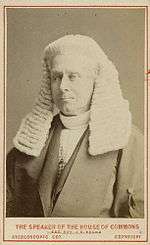Henry Brand, 1st Viscount Hampden
| The Right Honourable The Viscount Hampden GCB PC | |
|---|---|
 | |
| Speaker of the House of Commons | |
|
In office 1872–1884 | |
| Monarch | Queen Victoria |
| Preceded by | Sir Evelyn Denison |
| Succeeded by | Sir Arthur Wellesley Peel |
| Personal details | |
| Born | 24 December 1814 |
| Died |
14 March 1892 (aged 77) Pau, France |
| Nationality | British |
| Political party | Liberal |
| Spouse(s) | Eliza Ellice (1818-1899) |
Henry Bouverie William Brand, 1st Viscount Hampden GCB PC (24 December 1814 – 14 March 1892), was a British Liberal politician. He served as Speaker of the House of Commons from 1872 to 1884.
Background and education
Brand was the second son of General Henry Trevor, 21st Baron Dacre, who inherited the barony in 1851, second son of Thomas Brand and Gertrude Roper, 19th Baroness Dacre. His mother was Pyne, daughter of the Very Reverend the Hon. Maurice Crosbie, Dean of Limerick, son of the 1st Lord Brandon (Brandon's wife was a granddaughter of Sir William Petty, FRS). He descended, almost directly, from Colonel John Hampden, the patriot; his forebear Sir John Trevor III (1624–72) of Plas Teg, son of Sir John Trevor II of Plas Teg and Trevalun, by Anne daughter of Sir Edmund Hampden of Wendover, had married John Hampden's daughter Ruth, who was his first cousin. That is to say the 19th Baron Dacre (aka Gertrude Roper (d.1819) wife to Thomas Brand V (1749–94)) was the great-great-granddaughter of The Patriot.
He was educated at Eton and was a member of Brook's, Reform and Athenaeum clubs. Brand was in the Coldstream Guards for 12 years, from 20 April 1832 until 6 September 1844. He was their 963rd officer. His father, the General, had been their 690th officer serving 28 years between 1793 and 1821.
Political career

Brand entered parliament as a Liberal in 1852, sat for Cambridgeshire, and for some time was Chief Whip of his party. He was a Lord of the Treasury during the first Palmerston ministry, and Parliamentary Secretary to the Treasury during the second. At some point he was Keeper of the Privy Seal to the Prince of Wales. In 1872 he was elected speaker, and retained this post till February 1884. It fell to him to deal with the systematic obstruction of the Irish Nationalist Party, and his speakership is memorable for his action on 2 February 1881 in refusing further debate on W. E. Forster's Coercion Bill—a step which led to the formal introduction of the closure into parliamentary procedure.[1] He was appointed a GCB in 1881 and on his retirement he was created Viscount Hampden, of Glynde in the County of Sussex. In 1890 he also succeeded in the barony of Dacre on the death of his brother.
Estates
According to John Bateman, who derived his information from statistics published in 1873, Hon. Sir Henry Bouverie William Brand, G.C.B., of Glynde, Lewes, had 8,846 acres in Sussex (worth 8,121 guineas per annum).
Family

%2C_from_The_Country_Gentleman%2C_October_1881.jpg)
Lord Hampden married Eliza (1818-8 March 1899, Pelham House, Lewes), daughter of General Robert Ellice by his wife Eliza, illegitimate daughter of Charles Grey, 2nd Earl Grey by Georgiana, Duchess of Devonshire, in 1838. They had five sons and five daughters. His second son the Hon. Thomas Seymour Brand (1847–1916) was a Rear-Admiral in the Royal Navy and inherited Glynde Place, while his third son the Hon. Arthur Brand was also a Liberal politician. A daughter, Maud Bevan, was made a DBE for services to the Red Cross. Lord Hampden died on 14 March 1892, aged 77, and was succeeded in the viscountcy by his eldest son Henry. Lady Hampden died in March 1899.
References
- ↑
 One or more of the preceding sentences incorporates text from a publication now in the public domain: Chisholm, Hugh, ed. (1911). "Hampden, Henry Bouverie William Brand, 1st Viscount". Encyclopædia Britannica. 12 (11th ed.). Cambridge University Press. p. 900.
One or more of the preceding sentences incorporates text from a publication now in the public domain: Chisholm, Hugh, ed. (1911). "Hampden, Henry Bouverie William Brand, 1st Viscount". Encyclopædia Britannica. 12 (11th ed.). Cambridge University Press. p. 900. - ↑ Detail of portrait from The Country Gentleman, Sporting Gazette and Agricultural Journal, October 1881. Lithograph published by Vincent Brooks, Day & Son, Ltd.

External links
- Hansard 1803–2005: contributions in Parliament by Henry Brand, 1st Viscount Hampden
.svg.png)
